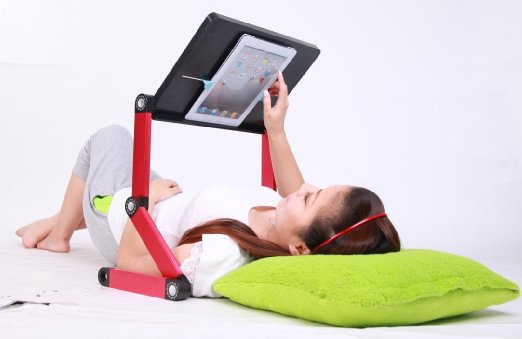

It started innocently enough—just a few hours of binge-watching my favorite series on my tablet.
But before I knew it, I found myself rubbing my sore neck, stretching my shoulders, and wondering why my head felt like it was being weighed down by an invisible anchor.
That’s when I realized it: I had developed what’s commonly known as “nerd neck”. I fondly term this condition as a turtle neck.
But how could something as harmless as viewing a tablet cause such a painful predicament? Let’s dive into the science behind it.
“How Viewing Tablet Gave Me a Nerd Neck” Article Index:
- What is Nerd Neck?
- How Tablet Viewing Leads to Nerd Neck
- The Science of Tablet Viewing and Neck Posture
- Signs and Symptoms of Nerd Neck from Tablet Use
- Scientific Studies on Tablet Viewing and Neck Health
- Preventive Tips for Avoiding Nerd Neck While Using a Tablet
- Exercises to Counteract Nerd Neck from Tablet Use
- FAQs on Tablet Viewing & Nerd Neck
- Conclusion: How Viewing a Tablet Gave Me a Nerd Neck
What is Nerd Neck?
Nerd neck, also known as “forward head posture” or “tech neck,” is a condition where your head juts forward compared to your shoulders, creating a misalignment in your cervical spine.
This posture is more than just an aesthetic issue—it can lead to chronic pain, muscle strain, and even long-term damage to your neck and spine.
But how does this happen? Blame it on modern technology.
Whether you are texting on your phone, typing on a laptop, or binge-watching your favorite show on a tablet, you are likely craning your neck forward.
This causes your head, which weighs about 10-12 pounds, to exert even more pressure on your neck muscles, leading to what we call “nerd neck.”
How Tablet Viewing Leads to Nerd Neck
Here are a few reasons that I identified:
The Viewing Angle Problem:
One of the primary culprits behind nerd neck is the angle at which we view our screens. Tablets are particularly notorious for this because they are usually held lower than eye level.
When you look down at your tablet for prolonged periods, your neck is forced into a forward-leaning position. The more you look down, the more strain you place on your cervical spine.
Increased Load on Neck Muscles:
According to a study published in the journal Surgical Technology International, the more your head tilts forward, the greater the pressure on your neck.
At a 15-degree tilt, your neck feels like it’s supporting about 27 pounds. Increase that tilt to 60 degrees, and the pressure skyrockets to 60 pounds.
Imagine holding a 60-pound weight at the back of your head all day—that is what your neck muscles are enduring!
Prolonged Static Posture:
Tablets are designed for convenience, which means they are often used in positions that encourage poor posture.
Whether you are lying on the couch, sitting at a table, or lounging in bed, prolonged static posture with your head bent forward can lead to muscle fatigue and imbalances.
Over time, this results in muscle tightness, reduced range of motion, and chronic neck pain—all hallmarks of nerd neck.
The Science of Tablet Viewing and Neck Posture
A quick look at the link between my neck posture and the tablet that I am so hooked onto:
The Role of Ergonomics:
Ergonomics plays a crucial role in how your body interacts with devices like tablets.
Unlike desktop computers, which are usually placed at eye level, tablets are often held below eye level. This creates a problematic viewing angle that leads to neck flexion.
A study published in the journal Applied Ergonomics found that using tablets on a flat surface like a desk resulted in a 15-degree neck flexion, while using them on your lap increased this angle to a whopping 63 degrees.
Muscle Imbalance and Overuse:
Your neck and shoulder muscles are designed to hold your head in a neutral position.
However, when you consistently crane your head forward to view a tablet, certain muscles like the trapezius and levator scapulae are overworked, while others, like the deep neck flexors, become underutilized.
This muscle imbalance can lead to nerd neck, muscle pain, stiffness, and even headaches.
Spinal Alignment Issues:
When you tilt your head forward for extended periods, the natural curve of your cervical spine is disrupted.
This misalignment can compress the discs in your neck, potentially leading to herniation or degenerative disc disease over time.
A study published in the journal Spine showed that forward head posture significantly increases the risk of cervical spine issues, particularly when combined with long-term tablet use.
Signs and Symptoms of Nerd Neck from Tablet Use
Wondering if you have fallen victim to nerd necking?
Here are some common signs and symptoms:
- Neck Pain: Often described as a dull ache or sharp pain, especially after using your tablet.
- Shoulder Tension: Tightness or discomfort in the shoulders and upper back.
- Headaches: Caused by tension in the neck and upper back muscles.
- Limited Range of Motion: Difficulty turning your head or looking up without pain.
- Postural Deformities: A noticeable forward head posture, sometimes accompanied by a rounded upper back (kyphosis).
If you’re experiencing any of these symptoms, it’s time to take action before your nerd neck becomes a long-term issue.
Scientific Studies on Tablet Viewing and Neck Health
A quick look at all the scientific research work that I conducted to understand he missing link between my nerd neck and viewing my tablet:
Study 1: Neck Pain and Tablet Use in College Students
A study published in the journal Work examined the prevalence of neck pain among college students who frequently used tablets.
The study found that 68% of students reported experiencing neck pain, with the majority attributing it to prolonged tablet use in non-ergonomic positions.
Study 2: Impact of Viewing Angle on Cervical Spine
Another study published in Physical Therapy Science investigated the impact of different tablet viewing angles on cervical spine load.
The results indicated that viewing angles lower than eye level significantly increased the compressive forces on the cervical spine, leading to an elevated risk of neck pain and musculoskeletal disorders.
Study 3: Long-Term Effects of Forward Head Posture
Research published in the journal Spine focused on the long-term effects of forward head posture on the cervical spine.
The study concluded that individuals with chronic forward head posture had a higher incidence of cervical disc degeneration and reduced neck muscle endurance, highlighting the need for proper ergonomic practices when using tablets.
Preventive Tips for Avoiding Nerd Neck While Using a Tablet
Here is what all I did to try and fix my turtle neck:
Elevate Your Tablet:
Use a tablet stand or stack of books to raise your device to eye level. This reduces the need to bend your neck forward, maintaining a neutral head position.
Take Frequent Breaks:
Set a timer to remind yourself to take breaks every 20-30 minutes. Stand up, stretch your neck and shoulders, and reset your posture before continuing.
Adjust Your Seating Position:
Choose a chair that supports your lower back and keeps your feet flat on the floor. Keep your elbows at a 90-degree angle and your shoulders relaxed to minimize strain.
Use Voice Commands:
If your tablet supports voice commands, use them to reduce the time spent hunched over your screen. This is especially useful for tasks like searching the web or sending messages.
Apply the 20-20-20 Rule:
Every 20 minutes, look at something 20 feet away for at least 20 seconds. This not only helps reduce eye strain but also encourages you to change your neck position.
Exercises to Counteract Nerd Neck from Tablet Use
A quick look at the 4 exercises I use to correct my forward neck:
Chin Tucks
Sit or stand with your back straight. Gently pull your head back, tucking your chin in as if making a double chin. Hold for 5 seconds and repeat 10 times.
Neck Stretches
Gently tilt your head to one side, bringing your ear towards your shoulder. Hold for 20 seconds and switch sides. Repeat 3 times on each side.
Shoulder Blade Squeezes
Sit or stand with your back straight. Squeeze your shoulder blades together as if trying to hold a pencil between them. Hold for 5 seconds and release. Repeat 10 times.
Wall Angels
Stand with your back against a wall, feet shoulder-width apart. Raise your arms to form a “W” shape, then slowly extend them to a “Y” shape while keeping your back and arms against the wall. Repeat 10 times.
FAQs on Nerd Neck caused by Viewing Tablets
Q-1: How does prolonged tablet viewing contribute specifically to developing “nerd neck”?
A-1: Prolonged tablet use often involves looking downward with the head tilted forward, which increases the load on the cervical spine. This sustained forward head posture strains the neck muscles and ligaments, gradually causing the characteristic rounded upper back and extended neck position known as “nerd neck.”
Q-2: Why is tablet use more likely to cause “nerd neck” compared to using a desktop computer or laptop?
A-2: Tablets are typically held lower and closer to the body, encouraging a more pronounced forward head tilt. As per bestforwardheadposturefix.com, “Unlike desktops or laptops, which can be adjusted to eye level, tablets lack ergonomic support, making it harder to maintain neutral neck alignment and increasing the risk of developing nerd neck.”
Q-3: Can the size and weight of a tablet influence the severity of “nerd neck”?
A-3: Yes, larger and heavier tablets tend to be held further away or require more effort to stabilize, increasing the tendency to lean forward. This intensifies neck muscle strain and worsens postural imbalances, accelerating the development of “nerd neck” symptoms.
Q-4: How do the frequent micro-adjustments made while using a tablet affect neck posture over time?
A-4: Constant small shifts to find a comfortable viewing angle can cause repetitive strain on certain neck muscles, while others remain underused. This uneven muscle engagement contributes to muscular imbalances that promote forward head posture and the progression of “nerd neck.”
Q-5: What role does the lack of built-in ergonomic features in tablets play in causing “nerd neck”?
A-5: Tablets lack adjustable stands or keyboards that facilitate proper alignment of the screen with the eyes and hands. This absence forces users to adopt awkward neck and shoulder positions, increasing mechanical stress on cervical structures and encouraging “nerd neck.”
Q-6: How can habitual tablet use during leisure activities, like reading or gaming, impact neck health differently than work-related use?
A-6: Leisure tablet use often involves more relaxed, unsupported postures with less frequent breaks, leading to prolonged static neck positions. This inactivity and poor posture during enjoyable activities can contribute to “nerd neck” even more than structured, work-related tablet use where posture may be more conscious.
Q-7: Are there early signs from tablet use that indicate the onset of “nerd neck” before severe symptoms develop?
A-7: Early signs include occasional neck stiffness, mild headaches, and subtle forward head positioning noticed in mirrors. Users may also experience quick onset of fatigue or discomfort after short tablet sessions, signaling the need for corrective posture and ergonomic adjustments to prevent “nerd neck” progression.
Takeaway: How Viewing a Tablet Gave Me a Nerd Neck
So, how did viewing a tablet give me a nerd neck?
The culprit was the awkward, prolonged position I held my head in while binge-watching my favorite shows.
The downward angle, the static posture, and the lack of ergonomic support all contributed to the development of forward head posture, a.k.a. nerd neck.
The good news is that with a few adjustments—like elevating your tablet, taking breaks, and incorporating neck exercises—you can prevent and even reverse the effects of nerd neck.
Remember, your posture is more than just about looking good; it is about feeling good too.
So, the next time you reach for your tablet, keep a sharp lookout for the best forward head posture fix methods. !
References:


